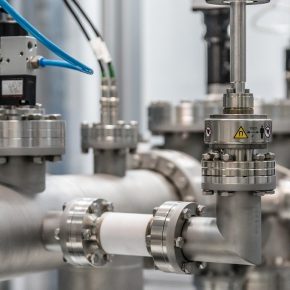
An introduction to heat pumps and hydrogen heating
A new report says trials of heat pumps and hydrogen heating are urgently needed to meet 2050 zero carbon targets; this article explains more…
Up to a third of the UK’s greenhouse emissions come from central heating, according to some estimates.
The National Infrastructure Commission (NIC), which advises the government on infrastructure policy, has said ‘the UK cannot achieve its emissions targets while relying on natural gas, a fossil fuel, for heating.’
Its new ‘NET ZERO Commission recommendations and the net zero target’ report said: “The increased volume of new heating systems that will need to be installed mean taking steps to trial heat pumps and hydrogen heating is even more urgent.
“Energy efficiency measures should be installed in the short term to reduce emissions from heat. Whichever approach the government chooses to take to decarbonise heat, energy efficiency measures will be needed to reduce energy demand from heat.
“Energy efficiency measures will be particularly important if heat is electrified, as heat pumps work best in buildings with reasonably high insulation standards as they provide constant, but low level, heat.”
Renewables and conservation of resources have long been top of the agenda. From householder to construction industry focused water use efficiency campaigns, encouragements to make use of leak detection and water use monitoring gadgetry and pushes to use renewable building materials, but a dramatic change to central heating systems is likely to soon be forced to the top of the agenda.
Heat pumps and hydrogen heating may become a big part of construction of the future.
Heat pumps
Heat pumps extract heat from the ground, air or a body of water and transfer it elsewhere, such as a home’s heating system.
Ground source heat pumps rely on a network of pipes laid in the ground to extract the heat while air source pumps use fans.
An accessible appropriate body of water is required to enable a water pump system.
Ground pumps
Ground pumps circulate water and antifreeze around a pipe system, laid either vertically or horizontally, in the land next to a building. A compressor is then used to raise the temperature of the fluid and circulate it around a building.
Due to the fact that below surface ground stays at a fairly constant temperature, heat is available year-round. Ground pumps can service heating and hot water requirements.
Vertical bore holes for a ground source system typically need to be around 90 metres to 160 metres deep, according to the Energy Saving Trust. While the space needed for a horizontal loop depends on localised factors, it says.
Air pumps
Air pumps rely on electricity to operate but the renewable energy generated is greater than the amount of electricity required.
In the UK, air-to-water systems are most common. They transfer the heat from the air into water which can be circulated around a home in the wet central heating system.
As heat pumps work at lower temperatures than standard boilers they are more suited to systems that emit heat at lower temperatures over longer periods, such as underfloor heating.
A hot water tank is required and homes must be well insulated.
As far back as 2013, Bennett Homes incorporated air-to-water pumps in a 22-unit housing development in Attleborough, Norfolk.
More recently, also in Norfolk, air source heat pumps have been included in a Crabtree Living 10-home development in Strumpshaw.
Hydrogen heating
Authors of the Transitioning to Hydrogen report concluded that our natural gas networks could be repurposed for hydrogen gas, which is abundantly available, in water, for example.
For consumers it would mean little discernible difference to what they are used to as gas appliances and boilers could be converted. In the 1960s and 70s a conversion took place in the UK from the use of town gas (which was mostly produced from coal and oil) to natural gas.
Earlier this year, Worcester Bosch revealed a prototype of a boiler that could be converted from operating with natural gas to hydrogen.
Latest news

29th April 2025
Senior pledges to ‘bee’ part of the solution with new biodiversity initiative
Senior Architectural Systems has installed its first on-site beehive, marking another step forward in its commitment to sustainability and biodiversity.
Posted in Articles, Building Industry News, Building Products & Structures, Building Services, Curtain Walling, Doors, Glass, Glazing, Innovations & New Products, news, Restoration & Refurbishment, Retrofit & Renovation, Sustainability & Energy Efficiency, Walls, Windows
29th April 2025
West Fraser range delivering key benefits for South-East carpentry company
An experienced carpenter and building site manager who has recently set up his own company is using high performance panel products from the West Fraser range.
Posted in Articles, Building Industry News, Building Products & Structures, Building Systems, Case Studies, Garden, Restoration & Refurbishment, Retrofit & Renovation, Sustainability & Energy Efficiency, Timber Buildings and Timber Products
29th April 2025
CPD Courses Available Online From Ecological Building Systems
Ecological Building Systems, a leading supplier of natural building products for sustainable construction, has revealed its comprehensive CPD programme for the year ahead.
Posted in Articles, Building Industry Events, Building Industry News, Building Products & Structures, Building Services, Continuing Professional Development (CPD's), Information Technology, Innovations & New Products, Insulation, Restoration & Refurbishment, Retrofit & Renovation, Seminars, Sustainability & Energy Efficiency, Training, Walls, Waste Management & Recycling
29th April 2025
WindowBASE launches new prospect databases at FIT Show
Visit WindowBASE at the FIT Show to see first-hand how it helps companies find new customers – the company is launching an easy-to-use, intuitive platform on Stand G16 at the NEC Birmingham from 29th April – 1st May.
Posted in Articles, Building Industry Events, Building Industry News, Building Products & Structures, Building Services, Doors, Exhibitions and Conferences, Glass, Glazing, Information Technology, Innovations & New Products, Posts, Publications, Research & Materials Testing, Restoration & Refurbishment, Retrofit & Renovation, Windows
 Sign up:
Sign up: